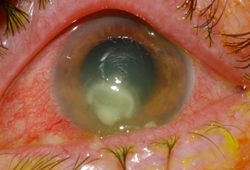Resumo
Definição
História e exame físico
Principais fatores diagnósticos
- presença de fatores de risco
- infiltrado corneano
- úlcera de córnea
- lesão epitelial dendrítica ou geográfica
- lesões cutâneas perioculares
- úlcera multifocal da córnea com bordas hifadas
- perineurite da córnea
- ceratite intersticial
Outros fatores diagnósticos
- vermelhidão
- dor
- lacrimejamento elevado
- edema da pálpebra
- secreção
- acuidade visual reduzida
- fotofobia
- pressão intraocular alta
- história de infecção por vírus do herpes simples ou vírus da varicela-zóster
- múltiplas cicatrizes estromais antigas
- transiluminação da íris
- hipoestesia da córnea
Fatores de risco
- uso de lentes de contato
- trauma corneano
- erosão/abrasão da córnea
- erosões recorrentes da córnea
- imunocomprometimento
- história de doença autoimune
- triquíase
- blefarite
- olho seco
- função deficiente da pálpebra
- doença herpética prévia
- ceratite por exposição
- exposição a água contaminada
- uso de corticosteroides tópicos
- uso de anestesia tópica
- cirurgia prévia do olho
Investigações diagnósticas
Primeiras investigações a serem solicitadas
- raspagem da córnea: microscopia de lâmina
- raspagem da córnea: culturas e sensibilidade
Investigações a serem consideradas
- Hemograma completo
- teste de HIV
- testes para doenças autoimunes
- raspagem da córnea: teste de reação em cadeia da polimerase
Algoritmo de tratamento
bacteriana (presumida): alto risco
bacteriana
herpética
fúngica
por protozoário (Acanthamoeba)
ceratite não infecciosa
infecção herpética recorrente
visão prejudicada por cicatrização da córnea
Colaboradores
Autores
Kraig S. Bower, MD
Director of Refractive Surgery
The Wilmer Eye Institute
The Johns Hopkins Hospital
Baltimore
MD
Declarações
KSB declares that he has no competing interests.
Frank S. Hwang, MD
Assistant Professor
Cornea, External Disease and Refractive Surgery
Loma Linda University Eye Institute
Loma Linda University
Loma Linda
CA
Declarações
FSH declares that he has no competing interests.
Agradecimentos
Dr Kraig S. Bower and Dr Frank S. Hwang would like to gratefully acknowledge Dr Julie Freidlin Leigh, a previous contributor to this topic.
Declarações
JFL declares that she has no competing interests.
Revisores
Matilda Chan, MD, PhD
Proctor Fellow in Cornea and External Disease
Francis I. Proctor Foundation
University of California
San Francisco
CA
Declarações
MC declares that she has no competing interests.
Parwez Hossain, MD, PhD, FRCOphth, FRCS (Ed)
Senior Lecturer & Consultant
Ophthalmic Surgeon
Division of Infection, Inflammation & Immunity
University of Southampton
Southampton General Hospital
Southampton
UK
Declarações
PH declares that he has no competing interests.
Créditos aos pareceristas
Os tópicos do BMJ Best Practice são constantemente atualizados, seguindo os desenvolvimentos das evidências e das diretrizes. Os pareceristas aqui listados revisaram o conteúdo pelo menos uma vez durante a história do tópico.
Declarações
As afiliações e declarações dos pareceristas referem--se ao momento da revisão.
Referências
Principais artigos
Rhee MK, Ahmad S, Amescua G, et al. Bacterial keratitis preferred practice pattern®. Ophthalmology. 2024 Apr;131(4):P87-133.Texto completo Resumo
Herretes S, Wang X, Reyes JM. Topical corticosteroids as adjunctive therapy for bacterial keratitis. Cochrane Database Syst Rev. 2014 Oct 16;(10):CD005430.Texto completo Resumo
Wilhelmus KR. Antiviral treatment and other therapeutic interventions for herpes simplex virus epithelial keratitis. Cochrane Database Syst Rev. 2015 Jan 9;(1):CD002898.Texto completo Resumo
Artigos de referência
Uma lista completa das fontes referenciadas neste tópico está disponível para os usuários com acesso total ao BMJ Best Practice.

Diagnósticos diferenciais
- Abrasão da córnea
- Ceratoconjuntivite vernal com úlcera em escudo
- Olho seco ou ceratite por exposição
Mais Diagnósticos diferenciaisDiretrizes
- Bacterial keratitis preferred practice pattern
- Cornea/external disease summary benchmarks - 2024
Mais DiretrizesFolhetos informativos para os pacientes
Herpes-zóster: o que é?
Infecção ocular por herpes simples
Mais Folhetos informativos para os pacientesConectar-se ou assinar para acessar todo o BMJ Best Practice
O uso deste conteúdo está sujeito ao nosso aviso legal